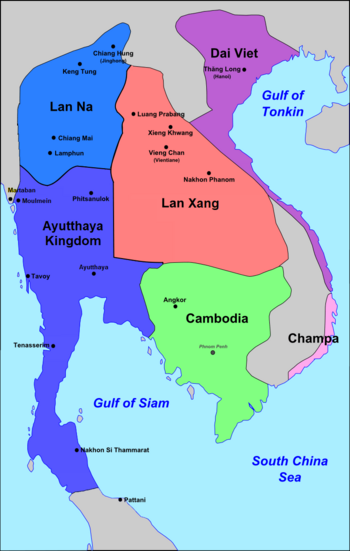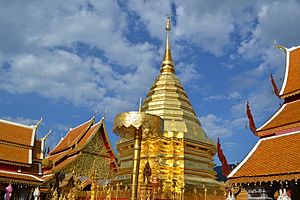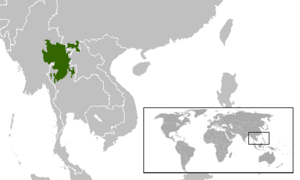Lan Na facts for kids
Quick facts for kids
Lan Na Kingdom
ᩋᩣᨱᩣᨧᩢᨠ᩠ᨠ᩼ᩃ᩶ᩣ᩠ᨶᨶᩣ
อาณาจักรล้านนา |
|||||||||||||||||||||||
|---|---|---|---|---|---|---|---|---|---|---|---|---|---|---|---|---|---|---|---|---|---|---|---|
| 1292–15 January 1775 | |||||||||||||||||||||||

Extent of Lan Na's zone of influence (dark blue), c. 1400.
|
|||||||||||||||||||||||
| Capital |
|
||||||||||||||||||||||
| Official languages |
|
||||||||||||||||||||||
| Spoken languages |
|
||||||||||||||||||||||
| Religion | Theravada Buddhism | ||||||||||||||||||||||
| Government | Monarchy | ||||||||||||||||||||||
| King | |||||||||||||||||||||||
|
• 1292–1311
|
Mangrai | ||||||||||||||||||||||
|
• 1441–1487
|
Tilokkarat | ||||||||||||||||||||||
|
• 1551–1564
|
Mekuti | ||||||||||||||||||||||
| Historical era | Early modern period | ||||||||||||||||||||||
|
• Capture of Hariphunchai
|
1292 | ||||||||||||||||||||||
|
• Foundation of Chiang Mai
|
1296 | ||||||||||||||||||||||
|
• Ayutthaya-Lan Na War
|
1456–1474 | ||||||||||||||||||||||
|
• Burmese rule
|
2 April 1558 | ||||||||||||||||||||||
|
• Fall of Chiang Mai
|
15 January 1775 | ||||||||||||||||||||||
|
|||||||||||||||||||||||
| Today part of | |||||||||||||||||||||||
The Lan Na Kingdom, also known as Lanna, was a powerful state in Southeast Asia. It existed from the 13th to the 18th centuries. Its main area was in what is now Northern Thailand. The name "Lan Na" means "Kingdom of a Million Rice Fields."
The people of Northern Thailand had a rich culture long before Lan Na. This kingdom grew out of an older one called Ngoenyang. By the 15th century, Lan Na was strong enough to challenge the Ayutthaya Kingdom. They even fought wars against each other.
However, Lan Na became weaker over time. In 1558, it became a tributary state of the Taungoo Dynasty from Burma. This meant it had to pay tribute to Burma. Lan Na was ruled by Burmese kings or local rulers who were loyal to Burma.
In 1775, the leaders of Lan Na decided to break free from Burmese control. They joined forces with Siam (modern-day Thailand). This led to a war between Burma and Siam. After this war, Siam took control of Lan Na in 1776. Lan Na then became a tributary state of Siam.
By the late 1800s, Siam slowly took away Lan Na's independence. It became part of the growing Siamese nation. By 1909, the Lan Na Kingdom no longer existed as a separate state.
Contents
What's in a Name?
The Lan Na kingdom was known by different names in other languages.
- In Burmese writings, it was called Zinme Pyi. Zinme is the Burmese name for Chiang Mai. It was also called Yun Pyi, with Yun being the Burmese word for the Northern Thai people.
- In the Laotian language, it was known as Anachak Lan Na.
- Old Pali writings called it Yonaraṭṭha (Kingdom of the Yun) or Bingaraṭṭha (Kingdom of the Mae Ping).
- In Chinese history books, it was called Babai Xifu.
History of Lan Na
How Lan Na Started
Mangrai was the 25th king of Ngoenyang. This kingdom was in the area of modern Chiang Saen. Mangrai brought together different small towns (called mueangs) into one kingdom. He also made friends with the nearby Phayao Kingdom.
In 1262, Mangrai moved his capital to a new city he founded, Chiang Rai. He named the city after himself. Mangrai then expanded his kingdom south. In 1281, he took over the Mon kingdom of Hariphunchai.
Mangrai moved his capital several times. He finally settled in and built Chiang Mai in 1296. This city became the main capital of Lan Na. Mangrai's kingdom included most of northern Thailand today. It also included parts of modern Myanmar, Laos, and China.
Times of Change and Growth

After Mangrai died around 1311, his son Grama became king. But there were some family struggles for the throne. Eventually, Mangrai's grandson, Pha Yu, became king. He moved the capital back to Chiang Mai. He made the city stronger and built important temples like Wat Phra Singh.
During the rule of King Kue Na, Theravada Buddhism became very important in Lan Na. Kue Na built the dhatu (a type of shrine) of Doi Suthep in 1386. He also invited monks from Sukhothai to help spread a new form of Buddhism.
Lan Na was mostly peaceful under King Saenmuengma. His name means "ten thousand cities arrive" (to pay tribute). The only big problem was a rebellion by his uncle. This led to the first fight between Lan Na and Ayutthaya.
Strong Rule Under Tilokkarat
The Lan Na kingdom was at its most powerful under King Tilokkarat (1441–1487). He took the throne from his father in 1441. Tilokkarat's brother tried to rebel with help from Ayutthaya, but Tilokkarat stopped him. In 1456, Tilokkarat conquered the nearby Kingdom of Payao.
To the south, the Ayutthaya Kingdom was also growing strong. Relations between Lan Na and Ayutthaya became bad. In 1451, a prince from Sukhothai joined Tilokkarat. This led to the Ayutthaya-Lan Na War. This war was fought over control of the Upper Chao Phraya valley. The war lasted many years, and Tilokkarat finally made peace in 1475.
Tilokkarat was also a strong supporter of Buddhism. In 1477, a big Buddhist meeting was held near Chiang Mai. Here, holy texts called the Tripitaka were put together again. Tilokkarat also built and fixed many important temples. He also expanded his kingdom to the west, into areas of the Shan States.
The Kingdom Weakens
After Tilokkarat, Lan Na faced many internal struggles among its princes. This made the kingdom weak and unable to defend itself. The Shan states that Tilokkarat had conquered broke free.
The last strong ruler was Paya Kaew. In 1507, Kaew attacked Ayutthaya but was pushed back. Ayutthaya then attacked Lan Na in 1513. Later, in 1523, a fight for power happened in the Kengtung State. Lan Na sent armies to help, but they were badly defeated. Lan Na never got its full power back after this loss.
In 1538, King Ketklao was overthrown by his own son. Ketklao became king again in 1543 but suffered from mental illness and was executed. His daughter, Chiraprapha, became queen. With Lan Na weakened by these struggles, both Ayutthaya and Burma saw a chance to take over.
Ayutthaya attacked Lan Na in 1545. Queen Chiraprapha made peace. But Ayutthaya attacked again the next year. They sacked Lampang and Lamphun. Chiraprapha was forced to make Lan Na a tributary state of Ayutthaya.
In 1546, Chiraprapha decided to step down. The nobles chose Prince Chaiyasettha of Lan Xang (modern-day Laos) to be the new king. He was her nephew. Chaiyasettha moved to Lan Na. In 1547, he returned to Lan Xang to become king there. He also took the famous Emerald Buddha statue from Chiang Mai to Luang Prabang. After he left, the nobles chose Mekuti to be the new king. He was a Shan ruler related to Mangrai.
Under Burmese Control
The kingdom then came into conflict with the powerful Burmese king Bayinnaung. Bayinnaung's armies invaded Lan Na in 1558. King Mekuti surrendered, and Lan Na came under Burmese rule.
Mekuti tried to rebel against Burma in 1564, but he was captured. Bayinnaung then made Wisutthithewi, a Lan Na royal, the queen. After she died, Bayinnaung appointed his son, Nawrahta Minsaw, as the ruler of Lan Na in 1579. Burma allowed Lan Na some freedom but controlled its taxes and labor.
After Bayinnaung died, his large empire began to fall apart. Siam successfully rebelled against Burma. By 1596, many of Burma's vassal states, including Lan Na, declared independence. Nawrahta Minsaw declared independence in 1596. In 1602, he became a tributary of Siam. However, Siam's control did not last long.
Burma tried to take over Lan Na again in the 1600s. Lan Na rulers, who were of Burmese descent, ruled for over 100 years. Siam tried to take Lan Na in 1662–1664 but failed.
By the 1720s, the Burmese empire was weakening. Chiang Mai revolted in 1727 because of high taxes. The rebels pushed back the Burmese army. Chiang Mai and the Ping valley became independent for a while. But Chiang Mai became a tributary to a new Burmese dynasty in 1757. It rebelled again in 1761 but was stopped. In 1765, Burma used Lan Na as a base to invade Laos and Siam.
The End of Burmese Rule
In the early 1770s, Burma was very strong. But the local Burmese government in Chiang Mai was very harsh. The governor, Thado Mindin, was disliked by everyone. One of the local chiefs, Kawila of Lampang, rebelled with help from Siam. They captured Chiang Mai on January 15, 1775. This ended 200 years of Burmese rule.
Kawila became the prince of Lampang, and Phraya Chaban became the prince of Chiang Mai. Both were loyal to Siam. Burma tried to get Lan Na back several times (1775–76, 1785–86, 1797) but failed.
In the 1790s, Kawila made his control over Lan Na stronger. He even tried to take over Burmese Shan states. The Kingdom of Chiang Mai became a vassal state of Siam. Under Siam, the Lan Na kingdom was divided into five smaller areas: Chiang Mai, Nan, Lampang, Lamphun, and Phrae. Lan Na stopped being a single kingdom after it became part of modern Siam.
Chiang Mai was under Burmese rule for over 200 years. But there were times when it was under Ayutthaya or was independent. For more than 30 years, it was ruled by a Lao king named Ong Kham from the Kingdom of Luang Prabang.
Lan Na Language
Kham Mueang or Phasa Mueang is the modern spoken form of the old Lan Na language. Kham Mueang means "language of the main towns." This is different from the languages of the many hill tribe peoples in the mountains. The language can be written using the old Lan Na script. This script looks a bit like Thai but has different spelling rules.
Historical Writings on Lan Na
- The Chiang Mai chronicles: These writings probably started in the late 1400s. They were added to each time they were copied. The current version is from 1828.
- Jinakālamāli: Written by Ratanapañña in the 1500s. It tells about how Buddhism grew in Thailand and many historical events.
- Zinme Yazawin: This is a Burmese history book about Zinme (Chiang Mai).
See also
 In Spanish: Lanna para niños
In Spanish: Lanna para niños
- List of rulers of Lan Na
- Kingdom of Chiang Mai
- Lan Na language



